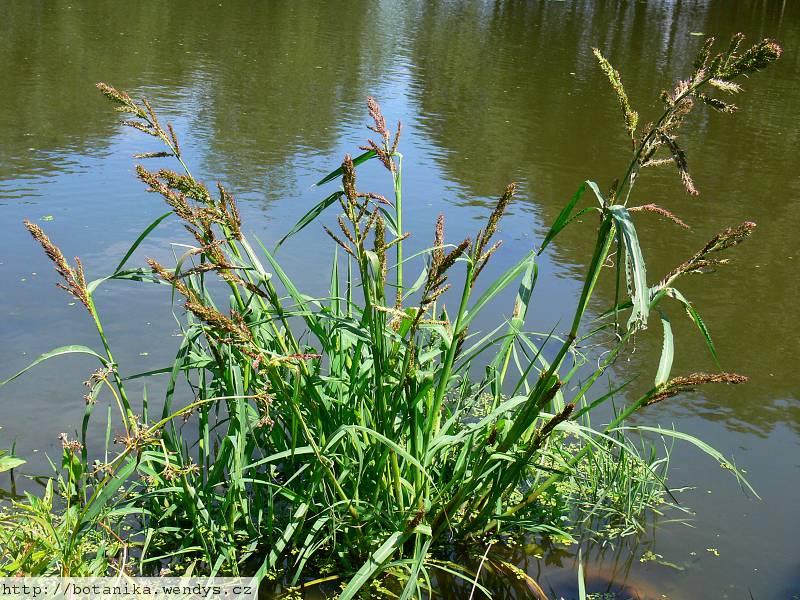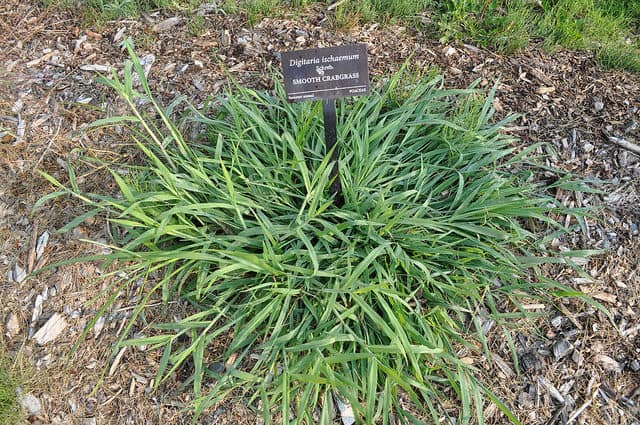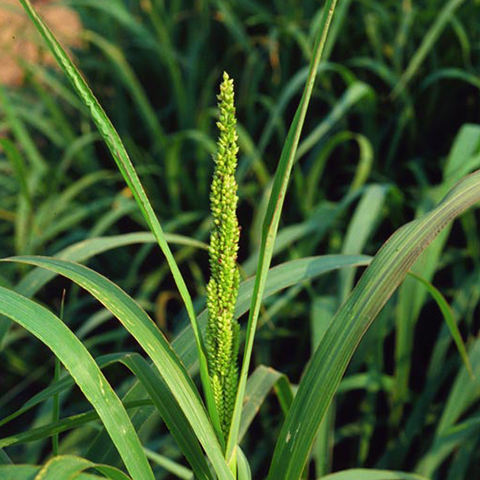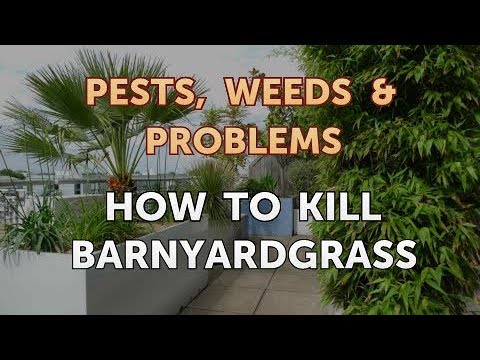To kill barnyard grass, apply a selective herbicide that targets grassy weeds, following the product’s instructions carefully. Barnyard grass can be a persistent and troublesome weed in gardens and lawns.
Its fast growth and spreading nature can quickly overtake desirable plants, causing damage to the overall appearance of the area. However, with the use of a selective herbicide specifically formulated to target grassy weeds, like barnyard grass, you can effectively eliminate this pesky invader.
This method is preferred over non-selective herbicides, as it will only target the unwanted weed and not harm other nearby plants. Follow the instructions on the herbicide packaging for proper application, ensuring the best chances of success in killing barnyard grass.

Credit: www.eattheweeds.com
Identifying Barnyard Grass
Barnyard grass can be a persistent and troubling weed in your garden or fields. Identifying this weed is crucial in effectively managing and eliminating it. By understanding the physical characteristics and habitat of barnyard grass, you can take the necessary steps to control and prevent its spread.
Physical Characteristics
Barnyard grass, scientifically known as Echinochloa crus-galli, belongs to the grass family Poaceae. It is an annual weed with a prominent seed head that resembles a fuzzy bottlebrush. The leaves are long, flat, and can reach up to 2 feet in length, with a wrinkled appearance. Their stems can grow up to 4 feet tall and are often branched.
Habitat
Barnyard grass thrives in moist, fertile soil and can be commonly found in agricultural fields, disturbed areas, gardens, and along the edges of water bodies. It can rapidly spread in areas with high nitrogen levels, making it a common sight in well-fertilized lawns and fields.

Credit: www.sweeneyslandscaping.com
How to Kill Barnyard Grass : Step by Step Guide
Preventing Barnyard Grass
Barnyard grass can be a persistent and pesky weed that can quickly take over your beautiful lawn if left unchecked. However, with some preventative measures and proper lawn maintenance, you can effectively keep barnyard grass at bay and maintain a healthy and lush lawn. In this article, we will discuss some key strategies for preventing barnyard grass and keeping your lawn in top shape.
Maintaining A Healthy Lawn
A healthy lawn is the best defense against barnyard grass and other unwanted weeds. By following these practices, you can ensure that your lawn remains strong and resistant to weed infestations:
- Regularly fertilize your lawn to promote growth and strengthen the grass. Use a slow-release fertilizer that provides the necessary nutrients without causing excessive growth that can attract weeds.
- Aerate your lawn to improve drainage and allow air and water to reach the roots. Compacted soil can weaken the grass, making it more susceptible to weed invasions.
- Ensure proper watering by providing adequate moisture without overwatering. Deep, infrequent watering encourages deep root growth, which helps the grass compete with weeds.
- Overseed your lawn with desirable grass species to fill in bare spots and prevent the growth of barnyard grass.
Proper Mowing
Proper mowing practices not only enhance the appearance of your lawn but also discourage the growth of barnyard grass. Below are some essential tips to keep in mind:
- Mow your lawn at the recommended height for the grass species you have. Cutting the grass too short weakens it and leaves room for weeds like barnyard grass to thrive.
- Regularly sharpen your lawn mower blades to ensure clean, precise cuts. Dull blades can tear the grass, creating openings for weed infestations.
- Alternate the direction of your mowing pattern each time you mow. This prevents the grass from developing a grain that favors the growth of barnyard grass and other weeds.
Tilling And Cultivation
Tilling and cultivation are effective practices for preventing barnyard grass before it becomes a problem. Here are some guidelines to follow:
- Before planting new grass or garden beds, thoroughly remove any existing barnyard grass by tilling the soil. This eradicates any weed seeds present in the top layer of the soil.
- Implement regular cultivation in areas prone to barnyard grass infestations. This disrupts the growth of young weeds and prevents them from establishing a foothold.
By incorporating these preventative measures into your lawn care routine, you can significantly reduce the likelihood of barnyard grass invading your yard. Remember, prevention is key when it comes to maintaining a healthy and weed-free lawn.
Mechanical Control Methods
When it comes to controlling barnyard grass in your garden or yard, mechanical methods of control can be highly effective. These methods involve physically removing or cutting down the grass to prevent it from spreading and taking over your desired plants and crops. Mechanical control methods are a sustainable and eco-friendly way to combat barnyard grass without the use of harmful chemicals. In this article, we will explore three common mechanical control methods: hand-pulling, mowing, and mulching.
Hand-pulling
Hand-pulling is a straightforward and practical method for dealing with barnyard grass. This method works best when the infestation is small, enabling easy identification and removal of individual grass plants. The key to success with hand-pulling is to ensure the entire root system is extracted, preventing regrowth. Follow these steps to effectively hand-pull barnyard grass:
- Identify the barnyard grass plants by their long, slender leaves and clusters of seed heads.
- Put on a pair of gardening gloves to protect your hands.
- Grasp the base of the grass plant firmly, close to the soil surface.
- Gently pull upwards, using a twisting motion if necessary, to ensure the entire plant and its roots are removed from the soil.
- Place the pulled grass plants in a bag or bucket for disposal, ensuring they do not come into contact with your other plants.
- Repeat the process for each individual barnyard grass plant in the infested area.
Mowing
Mowing is an effective method for controlling barnyard grass in larger areas or lawns. Regular mowing prevents the grass from reaching its flowering stage and reduces seed production, limiting its spread. Follow these tips for successful mowing:
- Mow your lawn or affected area regularly, ideally keeping the grass height at around 2 to 3 inches.
- Set your lawnmower blades to a higher setting to avoid cutting the grass too short, as this can stimulate barnyard grass growth.
- Dispose of the mowed grass clippings properly to prevent the spread of barnyard grass seeds. Bag them up and discard them in the appropriate waste disposal bins or compost them properly.
Mulching
Mulching is another effective method for suppressing barnyard grass growth and preventing weed seed germination. Applying a layer of organic mulch around your plants and garden beds helps to smother and suffocate any existing barnyard grass while creating a barrier that prevents new seeds from sprouting. Follow these steps to mulch your garden:
- Clear the area of any existing barnyard grass, ensuring all visible plants and roots are removed.
- Spread a layer of organic mulch, such as wood chips or straw, around your plants and garden beds. Aim for a thickness of around 3 to 4 inches.
- Avoid placing mulch directly against the stems or trunks of your plants, as this can create a damp environment that may promote disease.
- Regularly inspect the mulched area and remove any barnyard grass or other weeds that manage to penetrate through the mulch layer.
- Replenish the mulch layer as needed to maintain its thickness and effectiveness.

Credit: www.pedchem.com
Chemical Control Methods
Barnyard grass can be effectively controlled using chemical methods. When other control measures like cultivation or mulching are not feasible, chemicals such as selective herbicides and non-selective herbicides can be employed.
Selective Herbicides
Selective herbicides are effective in targeting specific types of plants while leaving others unharmed. When dealing with barnyard grass in a mixed planting, it is crucial to use selective herbicides to avoid damage to desirable plants. These herbicides work by targeting specific enzymes or growth processes within the barnyard grass, effectively impeding its growth without affecting the surrounding vegetation.
Non-selective Herbicides
Non-selective herbicides are designed to eliminate all plant life they come into contact with. When barnyard grass is the predominant weed and there are no desirable plants nearby, non-selective herbicides can be an effective solution. They work by disrupting key plant functions, resulting in the complete destruction of barnyard grass and other unwanted vegetation.
Long-term Management
Long-term management is key when it comes to effectively eliminating barnyard grass from your lawn. Taking proactive measures and implementing regular maintenance practices will help keep this invasive weed at bay, while promoting a lush and healthy lawn. In this section, we will go over a few important components of long-term management.
Regular Maintenance
Regular maintenance is crucial in preventing the growth and spread of barnyard grass. Here are a few steps you can take:
- Mow your lawn regularly to a proper height of around 2 to 3 inches.
- Remove any clippings or debris that may facilitate the growth of barnyard grass.
- Inspect your lawn regularly for any signs of barnyard grass, and promptly remove any plants that are spotted.
Overseeding
Overseeding is an effective technique in crowding out barnyard grass. By introducing desirable grass species, you can create dense turf that naturally suppresses weed growth. Consider the following steps:
- Choose a high-quality grass seed blend that is suitable for your region and existing lawn conditions.
- Prepare the soil by loosening it with a rake or tiller, and remove any existing dead grass or debris.
- Spread the grass seed evenly over the prepared soil, following the recommended seeding rate.
- Water the newly seeded area regularly to ensure proper germination and establishment.
- Monitor the overseeded area closely and continue with regular maintenance practices to promote healthy growth.
Proper Watering And Fertilization
Proper watering and fertilization are essential for maintaining a healthy lawn and reducing the chances of barnyard grass infestation. Consider the following guidelines:
- Water your lawn deeply and infrequently, allowing the soil to dry out between watering sessions. This helps encourage deep root growth and makes it more difficult for barnyard grass to thrive.
- Use a slow-release, balanced fertilizer to provide necessary nutrients to your grass without promoting excessive weed growth.
- Follow the recommended fertilization schedule for your specific grass species and climate.
Frequently Asked Questions Of How To Kill Barnyard Grass
What Is The Best Way To Kill Barnyard Grass?
To effectively eliminate barnyard grass, use a selective herbicide specifically designed for grassy weeds. Follow the manufacturer’s instructions carefully for optimal results. Additionally, regular mowing and maintaining a healthy lawn will help prevent the growth of barnyard grass.
What Chemicals Kill Barnyard Grass?
Chemicals like halosulfuron and quinclorac effectively kill barnyard grass in lawns and fields. Apply as directed to control growth and protect surrounding vegetation.
What’s The Difference Between Barnyard Grass And Crabgrass?
Barnyard grass and crabgrass differ in appearance and growth habits. Barnyard grass has broader leaves and grows upright, while crabgrass has thinner leaves and spreads low to the ground. Both are invasive weeds, but crabgrass is more common in lawns, while barnyard grass thrives in cultivated fields.
Why Is Barnyard Grass A Problem?
Barnyard grass is a problem because it competes with crops for nutrients, water, and sunlight, reducing their productivity. It can quickly multiply, overcrowding and shading fields. Its dense growth can also hinder mechanical harvesting and seedling establishment, leading to substantial yield losses.
Conclusion
In your quest to kill barnyard grass, remember these tips to effectively manage and eliminate it. By implementing these methods, you can successfully control barnyard grass and protect your lawn or garden. Stay vigilant, follow these strategies, and enjoy a weed-free outdoor space.
Keep up your efforts, and you’ll see the results you desire.

